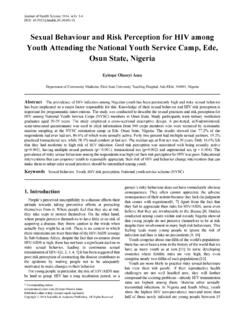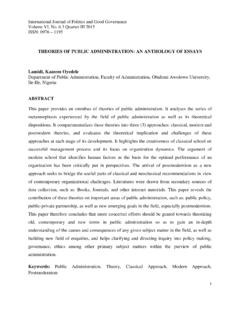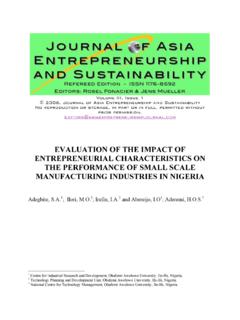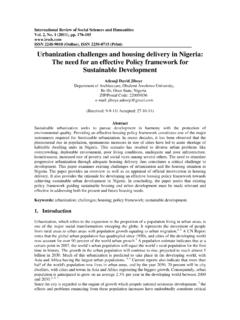Transcription of Nigeria: Female genital Mutilation - UNICEF
1 Nigeria: Female genital Mutilation Definition: Female genital Mutilation (or Female genital cutting), comprises all surgical procedures involving partial or total removal of the external genitalia or other injuries to the Female genital organs for cultural or other non-therapeutic reasons Background The practice of Female circumcision is widely known as Female genital Mutilation (FGM). Nigeria in the past had the highest absolute number of cases of FGM in the world amounting for about one quarter of the estimated 115-130 million circumcised women in the world. The practice is founded in traditional beliefs and societal pressure to conform.
2 The government of Nigeria in the last decade recognized the practice as harmful to children and women and have embarked on corrective measures, aimed at addressing the end of the practice openly and energetically, through the formulation of policies programmes, legislation and behavioral change that has currently impact reduction in prevalence. FGM is practiced in about 28 African countries as well as in a few scattered communities in other parts of the world. It is one of the most serious forms of violence against the girl child/woman and is practiced in Nigeria for a number of reasons: psychosexual: to attenuate sexual desire in the Female , maintain chastity and virginity before marriage and fidelity during marriage, and increase male sexual pleasure.
3 Sociological: for identification with the cultural heritage, initiation of girls into womanhood, social integration and maintenance of social cohesion and social acceptance. hygiene and aesthetics: among some societies, the external Female genitals are considered unclean and unsightly, and so are removed to promote hygiene and provide aesthetic appeal religious: Female genital Mutilation is practiced in a number of communities, under the mistaken belief that it is demanded by certain religions; others: to enhance fertility and promote child survival, better marriage prospects and helps delivery of babies Basic Statistics - Nigeria has a projected population of 126 million - Total Female population million - Female population 10years and above million - Female population married aged 10years and above million Prevalence of FGM among adult women by geo political zones North East per cent North Central
4 Per cent North West cent South West per cent South East per cent South South per cent Source: Nigeria Demographic and Health Survey: 2003 The Procedure This involves partial or total removal of the external Female genital and/or injury to the Female genital organs whether for cultural or any other non therapeutic reasons, and is commonly classified into three types:- Type1-Clitoridectomy is the least severe form of the practice and involves the removal of the hood or of the clitoris and or part of the clitoris itself.
5 Type 2 -This is a more severe practice involving the removal of the Clitoris along with partial or total excision of the labia minora. Type 3 -Is known as infibulation and the most severe form of FGM. It involves the removal of the clitoris, the labia minora and the adjacent medial part of the labia majora, and the stitching of the vaginal opening leaving an opening the size of a pinhead to allow for the flow of urine and menstrual blood. Knowledge and Prevalence of FGM Zones Percentage of Women who heard of FGM Percentage of Women Circumcised Types of Circumcision Type1 Type2 Type 3 North Central North East - - - North West - - - South East South South South West Implications FGM does irreparable harm.
6 It can result in death through severe bleeding, pain and trauma and overwhelming infections. It is routinely traumatic. It has dangerous health implications because of the unsanitary conditions in which it is generally practiced. It is a fundamental violation of human rights because it is carried out at a very young age when there is no possibility of the individual consent. Mutilated/cut infants, girls and women face irreversible lifelong health risks, among other consequences. Age at Circumcision: % 0 -12 Months 85 1-4 yrs 5-6 yrs 7-8 yrs 9-10 yrs 11-12 yrs 13+ Don t know/missing Person who performed the circumcision Traditional circumcisers Traditional birth attendant Other traditional methods Doctors Nurse/midwife Other health professionals Missing/don\t know Source.
7 Nigeria Demographic and Health Survey: 2003 Harmful effects include: Failure to heal Abscess formation Cysts Excessive growth of scar tissue Urinary tract infection Painful sexual intercourse Hepatitis and other blood-borne diseases Reproductive tract infection Pelvic inflammatory diseases Infertility Painful menstruation Chronic urinary tract obstruction/bladder stones Obstructed labor Increased risk of bleeding and infection during childbirth. Increased susceptibility to HIV/AIDS The eradication of FGM calls for urgent attention in the context of HIV/AIDS as the use of contaminated instrument in the operation could be an important mode of transmission.
8 The risks are evidenced from the fact that the operation is mainly carried out by practitioners of traditional medicine and by traditional birth attendants using unsanitary knives and other instruments in generally unhygienic conditions. The transmission of HIV/AIDS is an obvious danger, alongside the usual gynecological and psychological problems associated with the practice. These multiple risks are compounded in the case of infibulations by the need to cut open the infibulated area for childbirth. Carried out with crude, unsterilised instruments and without anaesthesia, the reopening operation causes intense pain and frequently results in infection and heavy bleeding.
9 In the worst of cases it can lead to: (i) the opening of passages between the vagina and bladder or anus, producing Vesico - Vaginal Fistula (VVF), a condition more commonly associated with the results of obstructed labor in early pregnancy but arising also in some cases from the cutting open of infibulated women; (ii) Recto Vaginal Fistula (RVF) - where due to age of the pregnant girl whose pelvis and birth canal are not fully developed, relentless pressure from the baby s skull damages the birth canal, causing breakage in the wall, allowing uncontrollable leakage from the bladder into vagina or uncontrollable leakage of faeces International Treaties on Female genital Mutilation FGM is a fundamental violation of the rights of children and women as outlined in numerous international conventions including Convention on the Rights of the Child and the Convention on the Elimination of all forms of Discrimination against Women.
10 It is an infringement on the physical and psychosexual integrity of women and girls It is discriminatory and violates: - the rights to equal opportunities in life; the right to the highest attainable standard of health, the right to freedom from all forms of physical and mental violence, injury or abuse; the right to be protected from traditional practices prejudicial to children and women s health; the right to make decisions concerning reproduction - free of discrimination, coercion and violence; the right to freedom from prejudices and all other practices that are based on the idea of inferiority or superiority of either of the sexes or in stereotyped roles for men and women.















